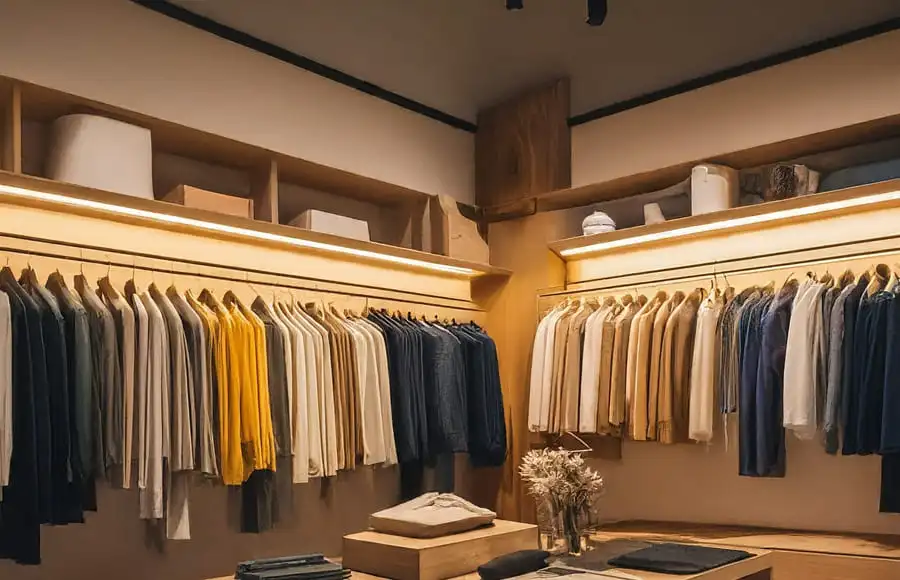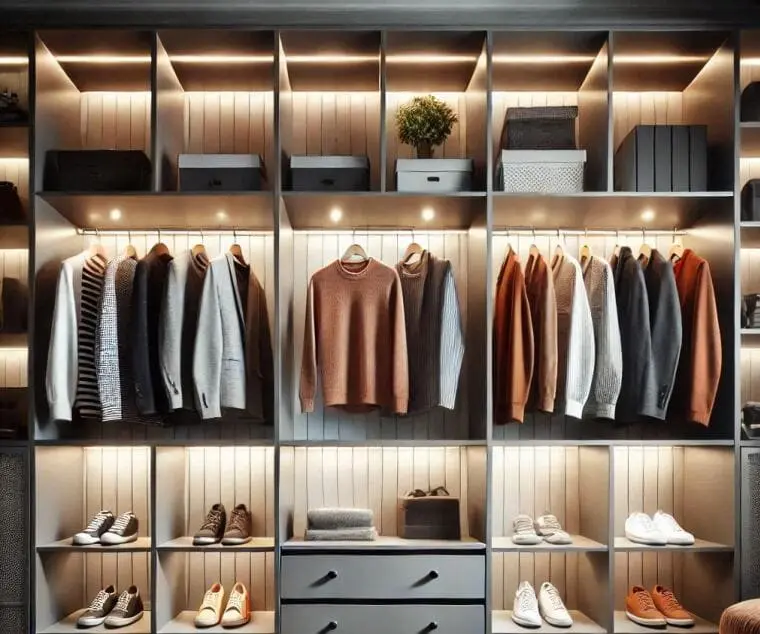Introduction
In closet lighting, good visibility is essential for both function and style. Whether you’re searching for that perfect outfit or organizing your space, the right lighting can make a significant impact.
LED lights are the best choice for closets. They are energy-efficient, last a long time, and give bright, clear light.In this guide, we’ll walk you through everything you need to know about choosing the perfect LED closet light for your space.
We will help you choose the right size, brightness, and style for your closet. We’ll also give you installation tips to improve its function and look.
Understanding the Importance of Proper Closet Lighting
Why Closet Lighting is Crucial for Function and Style
Closet lighting is often overlooked, but it’s key to both how your closet functions and how it looks. Not just about lighting up your clothes, but about making it easier and more enjoyable to get dressed.
Good lighting helps you see your outfits clearly, enhances the look of your wardrobe, and even boosts your mood. Bad lighting, however, can make things hard to find, leaving you frustrated and making your closet feel small and uninviting.

How the Right Lighting Changes Your Closet Experience
Think about walking into a closet where everything is easy to see—clothes, shoes, accessories—well-lit and ready to choose. That’s the power of good lighting. It turns a simple task like picking an outfit into something quick and enjoyable.
Whether you’re finding a dress or the right pair of shoes, good lighting makes everything clearer. It also sets the mood and creates an atmosphere that fits your style and space. You can use LED strips, recessed lighting, or other options to achieve this.
Making Your Closet More Organized with Good Lighting
A messy closet can feel overwhelming, but with the right lighting, you can make it look more organized. Task lighting over shelves, rods, and shoe racks helps highlight different sections, making it easier to find what you need.
Proper lighting also removes shadows and dark spots, so every inch of your closet is visible. This not only helps you find things faster but also makes your closet feel more ordered and accessible. When everything is well-lit, keeping your closet organized becomes much easier.
Key Factors to Consider When Choosing LED Closet Lights
Choosing the perfect LED closet light involves several considerations to ensure you achieve best illumination. Here’s a comprehensive guide to help you make the best choice for your space.
1. Understand the Types of Lighting Needed
A well-lit closet requires a mix of lighting to serve different functions:
• Ambient Lighting: Provides overall illumination for the entire space. Flush mount or recessed lights are ideal because they distribute light evenly without occupying valuable space.
• Task Lighting: Targets specific areas, like shelves or clothing rods. LED strip lights or puck lights installed under shelves or along rods help illuminate these areas for better visibility.
• Accent Lighting: Adds style and highlights specific features, such as accessories, artwork, or shelving. Decorative fixtures or LED tape lighting can be used to create a pleasing visual effect.
2. Evaluating Your Closet Size and Layout
Before choosing your LED closet light, it’s essential to assess the size and layout of your space. A small reach-in closet will require different lighting considerations than a large walk-in closet.
The goal is to make sure the light reaches every corner of the space. We want to avoid bright spots and dark areas that are hard to see.
Measure the space and consider how the layout works. Do you have a central area, shelves on the sides, or a long, narrow shape? This evaluation will help you determine how much light you need and where to place fixtures for the best coverage.
3. Understanding Different Closet Storage Needs (Clothes, Shoes, Accessories)
Not all items in your closet need the same amount of light. Hanging clothes need good overall lighting. However, shelves with shoes or accessories need focused light. This helps highlight and show off the items.
If you have a lot of drawers or cubbies, these spaces may need lighting designed to illuminate their interiors. Identify what’s in your closet, and consider different lighting types for different zones.
For example, overhead lighting is good for general visibility. However, under-shelf lighting or puck lights may work better for shoes, jewelry, or bags.
4. Identifying Dark Spots and Areas in Need of Extra Illumination
Every closet has its dark spots. These can be corners where light doesn’t reach or areas behind a big wardrobe. These hidden spaces often make it difficult to see or organize your clothes.
Walk into your closet, turn off the lights, and visually inspect the areas that seem too dark. This will help you pinpoint where additional lighting is necessary. You may need to consider task lights, under-shelf illumination, or motion-sensing lights to brighten these dark spots.
Identifying and addressing these areas ensures that your closet is well-lit and fully functional.
5. Brightness (Lumens)
• Determining the Right Brightness: The amount of light you need depends on the size and purpose of your closet. Task lighting (for shelves or rods) may need higher lumen output, while ambient lighting can be softer.
• Recommended Lumen Levels: Aim for about 200-300 lumens per square meter for ambient lighting and 400-600 lumens for task lighting in areas like shelves or hanging rods.
Types of LED Closet Light Fixtures
1. Recessed LED Lights
• Sleek and Low-Profile: Recessed LED lights are perfect for achieving a clean, modern look in your closet. They install these lights right into the ceiling. They have a sleek design that does not consume visual space.
• Installation Tips: Position recessed lights strategically across the ceiling to ensure even coverage. Space them evenly for maximum light distribution, especially in larger closets or walk-in areas. For smaller closets, one or two well-placed lights can provide sufficient brightness.
2. LED Strip Lights
• Flexible Installation:LED strip lights are very flexible. You can install them on shelves, in drawers, or around corners to light up certain areas. They are perfect for highlighting clothing racks, shoe shelves, or accessories.
• Customization Tips: Use LED strips to create a modern, streamlined aesthetic. You can cut them to size and choose from a variety of color temperatures to match your closet’s style. For a neat finish, tuck the strips under shelves or behind molding to hide any visible wiring.
3. LED Puck Lights
• Focused Lighting: Puck lights are small, circular LED fixtures that provide focused light. They are ideal for display shelves, shoe racks, or areas where specific illumination is needed.
• Easy Installation and Positioning: Puck lights are simple to install with adhesive backing or small screws. Place them under shelves or above shoe racks to spotlight key areas and create a stylish, functional setup.

4. LED Ceiling Lights and Panels
• Best for Larger Spaces: For walk-in closets or large storage spaces, LED ceiling lights or panels provide uniform, wide illumination. They ensure every corner of your closet is visible, eliminating shadows.
• Full Visibility: Ceiling-mounted LED panels offer even coverage across the entire room, making them perfect for areas where uniform lighting is needed. They also help reduce the need for multiple light sources, simplifying installation.
5. Track Lighting
• Flexible and Adjustable: Track lighting offers versatility in lighting placement. The tracks can be mounted on the ceiling and adjusted to highlight specific sections of your closet, such as shelving units or hanging areas.
• Customizable Illumination: With adjustable heads, track lighting allows you to focus light where it’s most needed, providing flexibility and control over your closet’s lighting setup.
6. Motion-Activated LED Lights
• Convenience and Energy Efficiency: Motion-activated lights automatically turn on when you open your closet door or when they detect movement. These are perfect for hands-free operation, saving energy and adding convenience to your space.
• Energy-Saving Feature: Motion sensors ensure that the lights are only on when you need them, helping reduce electricity usage and prolonging the lifespan of your LED lights.
Installation Tips for Your LED Closet Lights
DIY vs. Professional Installation: Which Option is Right for You?
When deciding whether to install your LED closet lights yourself or hire a professional, consider the following:
• DIY Installation: Ideal for those with basic electrical knowledge or for smaller projects. Many LED lights, especially battery-operated or plug-in types, can be installed without much hassle.
• Professional Installation: Recommended for larger projects or if your closet requires hardwiring or complex electrical work. Hiring an electrician ensures safety and adherence to local codes.
How to Install LED Strip Lights for Even Coverage
Installing LED strip lights can provide continuous, even illumination. Here’s how to do it:
1. Measure your closet’s dimensions to determine the length of LED strips you need.
2. Clean the surface where the strip will be applied to ensure strong adhesion.
3. Peel off the adhesive backing on the LED strips and attach them along the desired location (e.g., along shelves, edges, or under cabinets).
4. Connect the power supply, ensuring it’s positioned where you can plug it in or wire it to a power source.
5. Test the light to ensure even coverage and adjust placement as needed.
Wiring and Mounting Tips for Recessed or Ceiling-Mounted LED Lights
For a sleek and integrated lighting solution, recessed or ceiling-mounted lights are ideal. Follow these tips:
1. Determine Placement: Position the lights for even distribution, ensuring no areas are left too dark.
2. Drill Holes for Mounting: If installing recessed lights, measure and drill precise holes in the ceiling.
3. Connect Wiring: Recessed lighting often requires hardwiring, so connect wires to the light fixtures, ensuring proper insulation and connections.
4. Mount the Lights: Secure the fixtures into place, ensuring they are flush with the ceiling for a clean look.
5. Check the Circuit: Ensure your circuit can handle the load, and always use the appropriate safety measures.
Pre-Installation Considerations: Planning for Wiring and Power Sources
Before you begin installing LED lights, planning for wiring and power sources is crucial:
1. Assess Available Power Outlets: Determine if your closet has an accessible power source or if you’ll need to install a new one.
2. Plan Wire Placement: For hardwired lights, plan the route for the wiring to avoid exposed cables. Conceal the wires within walls, ceilings, or along baseboards.
3. Check Circuit Capacity: Ensure that the circuit you’re using can handle the additional load, especially if you’re installing multiple fixtures.
4. Consider a Power Strip or Extension Cord: For simpler installations, use a power strip or extension cord to connect your LED lights to an existing outlet. Make sure the power strip is rated for the load you’ll be using.

Smart LED Lighting for Closets
1. Benefits of App-Controlled and Remote Lighting
Smart LED lighting allows you to control your closet lights directly from your smartphone or tablet through a dedicated app. This level of control offers unparalleled convenience, allowing you to:
• Adjust brightness: Easily increase or decrease the light intensity based on your needs.
• Change color temperatures: Switch between warm, cool, or neutral lighting to match your mood or style.
• Create lighting scenes: Set up pre-programmed lighting setups for different times of day, like bright lighting in the morning or softer lighting in the evening.
• Turn lights on or off remotely: Forgot to turn off your closet light? With app control, you can do it from anywhere.
2. Integration with Home Automation Systems
Smart LED closet lights can be integrated with your home automation system (like Google Home or Amazon Alexa) for even more control. This means you can:
• Voice control: Turn your closet lights on or adjust their brightness simply by using voice commands.
• Automated routines: Set your lights to turn on when you open the door or adjust automatically as part of your daily routines.
• Seamless integration: Control all your home’s lighting, including closet lights, from one unified platform, giving you a streamlined, connected experience.
3. Scheduling Lights for Energy Efficiency
Smart LED lights come with scheduling features that help save energy and reduce electricity bills. You can:
• Set automatic on/off times: Program your lights to turn on when you need them and off when you don’t, ensuring they are only used when necessary.
• Dim lights during low-traffic hours: Adjust the light intensity based on the time of day or when the closet isn’t in use.
• Energy monitoring: Some smart lighting systems offer energy usage reports, helping you track your consumption and make adjustments to optimize savings.
By combining these features, smart LED closet lighting provides unmatched convenience, control, and energy efficiency—transforming your closet into a smarter, more efficient space.
Conclusion
Choosing the right LED closet light is about balancing functionality and aesthetics. Whether you choose recessed LED lights, strip lights, puck lights, or smart LED options, each choice should enhance the visibility and organization of your space.
Ready to upgrade your closet lighting? Browse through our selection of LED lights and find the perfect match for your space. Whether you’re looking for sleek and modern designs or practical, energy-efficient solutions, there’s an LED option waiting for you. Start transforming your closet into a well-lit, organized haven today!
Author
-

I'm Joseph, the Co-founder of CST Lighting, bringing over a decade of expertise in the LED lighting industry. With a strong focus on product marketing, I am dedicated to staying at the forefront of market trends, constantly enhancing my knowledge and skills to deliver top-notch products and services to our clients. Through our insightful blog posts, we strive to share our expertise, guiding readers through the ever-evolving landscape of LED lighting.
View all posts
Learn more via my linkedin profile https://www.linkedin.com/in/ledcst-joseph/